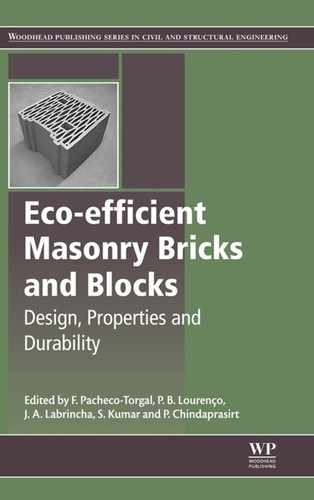Berge B. The ecology of building materials. 2nd ed. Architectural Press; 2009: 978-1-85617-537-1 Elsevier Science.
Bingel P, Bown A. Sustainability of masonry in construction. In: Khatib J, ed. Sustainability of construction materials. Cambridge: Woodhead Publishing Limited; 2009.
Cabeza L.F, Barreneche C, Miró L, Morera J, Bartolí E, Fernández A. Low carbon and low embodied energy materials in buildings: a review. Renewable and Sustainable Energy Reviews. 2013;23:536–542.
Campbell J, Pryce W. Brick: A world history. Thames & Hudson; 2003.
E.E.A. Report 12. Climate change, impacts and vulnerability in Europe 2012. Copenhagen: European Environment Agency; 2012.
European Commission. COM 571. (2011). Roadmap to a resource efficient Europe.
Freedonia Group. Brick & block to 2014-industry market research, market share, market size, sales, demand forecast, market leaders, company profiles, industry trends. Cleveland; 2010. http://www.freedoniagroup.com/Brick-And-Block.html.
Guillaud H. Characterization of earthen materials. In: Avrami E, Guillaud H, Hardy M, eds. Terra literature review—an overview of research in earthen architecture conservation. Los Angeles (United States): The Getty Conservation Institute; 2008:21–31.
Habla. The brick industry. Zig-Zag Kilns Technology; 2014. http://www.hablakilns.com/industry.htm.
Hall M, Lindsay R, Krayenhoff M. Modern earth buildings. Cambridge: WoodHead Publishing; 2012.
Harrison D.J, Bloodworth A.J, Eyre J.M, Macfarlane M, Mitchell C.J, Scott P.W, et al. Utilisation of mineral waste: case studies. 2002 British Geological Survey Commissioned Report CR/02/227 N.
IEA. World Energy Outlook 2012. Paris: OECD/IEA; 2012.
Lechtenbohmer S, Schuring A. The potential for large-scale savings from insulating residential buildings in the EU. Energy Efficiency. 2011;4:257–270.
Lourenço P, Vasconcelos G, Medeiros P, Gouveia J. Vertically perforated clay brick masonry for loadbearing and non loadbearing masonry walls. Construction and Building Materials. 2010;24:2317–2330.
Lynch G. Brickwork: history, technology (in italics) and practice. London: Donhead; 1994.
Morton T. Earth masonry – design and construction guidelines. HIS BRE Press; 2008.
Pacheco-Torgal F, Cabeza L, Mistretta M, Kaklauskas A, Granqvist C.G. Nearly zero energy building refurbishment. A multidisciplinary approach. London, UK: Springer Verlag; 2013.
Pacheco-Torgal F, Faria J, Jalali S. Embodied energy versus operational energy. Showing the shortcomings of the energy performance building directive (EPBD). Materials Science Forum. 2013;730–732:587–591.
Pacheco-Torgal F, Fucic A, Jalali S. Toxicity of building materials. Cambridge, UK: Woodhead Publishing Limited, Abington Hall; 2012.
Pacheco-Torgal F, Jalali S. Eco-efficient construction and building materials. London: Springer Verlag; 2011 p. 247.
Pacheco-Torgal F, Jalali S. Earth construction: lessons from the past for future eco-efficient construction. Construction and Building Materials. 2012;29:512–519.
Pacheco-Torgal F, Labrincha J. The future of construction materials research and the seventh UN millennium development goal: a few insights. Construction and Building Materials. 2013;40:729–737.
Pacheco-Torgal F, Labrincha J, Tam V, Ding Y, de Brito J. Handbook of recycled concrete and other demolition waste. Cambridge: Woodhead Publishing Limited; 2013.
Reddy B, Jagadish K. Embodied energy of common and alternative building materials and technologies. Energy Build. 2003;35:129–137.
Sabapathy A, Maithel S. A multi-criteria decision analysis based assessment of walling materials in India. Building and Environment. 2013;64:107–117.
Sandrolini F, Franzoni E. Embodied energy of building materials: a new parameter for sustainable architectural design. International Journal of Heat and Technology. 2010;27:163–167.
Sanya T. Living earth. The sustainability of earth architecture in Uganda (Ph.D. thesis). Norway: The Oslo School of Architecture and Design; 2007.
Scully V. Louis I. Khan and the ruins of Rome. Engineering & Science; 1993 pp. 3–13, Winter.
Seto K.C, Buneralp B, Hutyra L.R. Global forecasts of urban expansion to 2030 and impacts on biodiversity and carbon pools. PNAS; 2012 pp. 17–21.
Sonigo P, Hestin M, Mimid S. Management of construction and demolition waste in Europe. Brussels: Stakeholders Workshop; 2010.
Sousa L.C, Castro C.F, Antonio C.C, Sousa H. Topology optimisation of masonry units from the thermal point of view using a genetic algorithm. Construction and Building Materials. 2011;25(5):2254–2262.
Stephan Schmidheiny with BCSD. Changing course: A global perspective on development and the environment. Cambridge, MA: MIT Press; 1992.
WHO. (2014). Urban population growth. Global Health observatory. http://www.who.int/gho/urban_health/situation_trends/urban_population_growth_text/en/.
Zaman A.U, Lehmann S. The zero waste index: a performance measurement tool for waste management systems in a ‘zero waste city’. Journal of Cleaner Production. 2013;50(2013):123–132.
Zami M, Lee A. Stabilised or un-stabilised earth construction for contemporary urban housing? In: 5th international conference on responsive manufacturing ‘green manufacturing’. China: Ningbo Higher Education Park, the University of Nottingham Ningbo; January, 2010:11–13.
Zhang L. Production of bricks from waste materials – a review. Construction and Building Materials. 2013;47:643–655.


